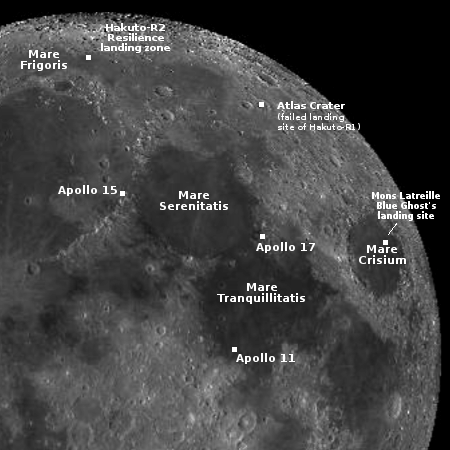SpaceX successfully launches two commercial lunar landers

Landing sites for both Firefly’s Blue Ghost and
Ispace’s Resilience
SpaceX tonight successfully launched two different private commercial lunar landers, its Falcon 9 rocket lifting off from the Kennedy Space Center in Florida.
The prime payload was Firefly’s Blue Ghost lunar lander, flying ten science payloads to the Moon for NASA. It will take about six weeks to get to lunar orbit. The second payload was Resilience or Hakuto-R2, built by the Japanese startup Ispace on that company’s second attempt to land on the Moon. It is taking a longer route to the Moon, 4 to 5 months. The map to the right shows the landing locations for both landers. It also shows the first landing zone for Ispace’s first lander, Hakuto-R1, inside Atlas Crater. In that case the software misread the spacecraft’s altitude. It was still three kilometers above the ground when that software thought it was just off the surface and shut down its engines. The spacecraft thus crashed.
For context, the map also shows the landing sites of three Apollo missions.
Both spacecraft were correctly deployed into their planned orbits.
The first stage successfully completed its fifth flight, landing on a drone ship in the Atlantic.
The 2025 launch race:
8 SpaceX
2 China
Right now SpaceX’s launch pace exceeds once every two days. If it can even come close to maintaining that pace, it will easily match its goal of 180 launches in 2025.
On Christmas Eve 1968 three Americans became the first humans to visit another world. What they did to celebrate was unexpected and profound, and will be remembered throughout all human history. Genesis: the Story of Apollo 8, Robert Zimmerman's classic history of humanity's first journey to another world, tells that story, and it is now available as both an ebook and an audiobook, both with a foreword by Valerie Anders and a new introduction by Robert Zimmerman.
The print edition can be purchased at Amazon or from any other book seller. If you want an autographed copy the price is $60 for the hardback and $45 for the paperback, plus $8 shipping for each. Go here for purchasing details. The ebook is available everywhere for $5.99 (before discount) at amazon, or direct from my ebook publisher, ebookit. If you buy it from ebookit you don't support the big tech companies and the author gets a bigger cut much sooner.
The audiobook is also available at all these vendors, and is also free with a 30-day trial membership to Audible.
"Not simply about one mission, [Genesis] is also the history of America's quest for the moon... Zimmerman has done a masterful job of tying disparate events together into a solid account of one of America's greatest human triumphs."--San Antonio Express-News

Landing sites for both Firefly’s Blue Ghost and
Ispace’s Resilience
SpaceX tonight successfully launched two different private commercial lunar landers, its Falcon 9 rocket lifting off from the Kennedy Space Center in Florida.
The prime payload was Firefly’s Blue Ghost lunar lander, flying ten science payloads to the Moon for NASA. It will take about six weeks to get to lunar orbit. The second payload was Resilience or Hakuto-R2, built by the Japanese startup Ispace on that company’s second attempt to land on the Moon. It is taking a longer route to the Moon, 4 to 5 months. The map to the right shows the landing locations for both landers. It also shows the first landing zone for Ispace’s first lander, Hakuto-R1, inside Atlas Crater. In that case the software misread the spacecraft’s altitude. It was still three kilometers above the ground when that software thought it was just off the surface and shut down its engines. The spacecraft thus crashed.
For context, the map also shows the landing sites of three Apollo missions.
Both spacecraft were correctly deployed into their planned orbits.
The first stage successfully completed its fifth flight, landing on a drone ship in the Atlantic.
The 2025 launch race:
8 SpaceX
2 China
Right now SpaceX’s launch pace exceeds once every two days. If it can even come close to maintaining that pace, it will easily match its goal of 180 launches in 2025.
On Christmas Eve 1968 three Americans became the first humans to visit another world. What they did to celebrate was unexpected and profound, and will be remembered throughout all human history. Genesis: the Story of Apollo 8, Robert Zimmerman's classic history of humanity's first journey to another world, tells that story, and it is now available as both an ebook and an audiobook, both with a foreword by Valerie Anders and a new introduction by Robert Zimmerman.
The print edition can be purchased at Amazon or from any other book seller. If you want an autographed copy the price is $60 for the hardback and $45 for the paperback, plus $8 shipping for each. Go here for purchasing details. The ebook is available everywhere for $5.99 (before discount) at amazon, or direct from my ebook publisher, ebookit. If you buy it from ebookit you don't support the big tech companies and the author gets a bigger cut much sooner.
The audiobook is also available at all these vendors, and is also free with a 30-day trial membership to Audible.
"Not simply about one mission, [Genesis] is also the history of America's quest for the moon... Zimmerman has done a masterful job of tying disparate events together into a solid account of one of America's greatest human triumphs."--San Antonio Express-News


Good landing on Read The Instructions ship. R.I.P. – Scuttle the seagull.
https://x.com/JoelWard2000/status/1879415449651425773